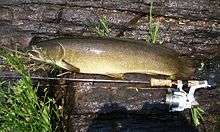Amiidae
The Amiidae are a family of basal ray-finned fishes. The bowfin is the only species to survive today, although additional species in all four subfamilies of Amiidae are known from Jurassic, Cretaceous, and Eocene fossils.[1]
| Amiidae | |
|---|---|
 | |
| Scientific classification | |
| Kingdom: | Animalia |
| Phylum: | Chordata |
| Class: | Actinopterygii |
| Order: | Amiiformes |
| Superfamily: | Amioidea |
| Family: | Amiidae Bonaparte, 1838 |
| Subfamilies | |
|
See text | |
Bowfins are now found throughout eastern North America, typically in slow-moving backwaters, canals, and ox-bow lakes. When the oxygen level is low (as often happens in still waters), the bowfin can rise to the surface and gulp air into its swim bladder, which is lined with blood vessels and can serve as a primitive lung.

Cyclurus kehreri fossil
Taxonomy
The family is divided into four subfamilies, with 11 genera described:[1]
- Amiidae
- Subfamily Amiinae
- Genus Amia
- Genus †Cyclurus
- Genus †Pseudoamiatus
- Subfamily †Amiopsinae
- Genus †Amiopsis
- Subfamily †Solnhofenamiinae
- Genus †Solnhofenamia
- Subfamily †Vidalamiinae
- Genus †Calamopleurus
- Genus †Maliamia
- Genus †Melvius
- Genus †Pachyamia
- Genus †Vidalamia
- Subfamily incertae sedis
- Genus †Nipponamia
- Subfamily Amiinae
gollark: That seems poorly thought out then.
gollark: They do that automatically, I'm fairly sure.
gollark: No. I think chickens are best but stupidly expensive.
gollark: Cøøł.
gollark: Just not 2G thuweds or saltkins.
References
- Grande, L.; Bemis, W.E. (1998). "A Comprehensive Phylogenetic Study of Amiid Fishes (Amiidae) Based on Comparative Skeletal Anatomy. An Empirical Search for Interconnected Patterns of Natural History". Memoir (Society of Vertebrate Paleontology). 4: 1–679. JSTOR 3889331.
External links
| Wikispecies has information related to Amiidae |
This article is issued from Wikipedia. The text is licensed under Creative Commons - Attribution - Sharealike. Additional terms may apply for the media files.
